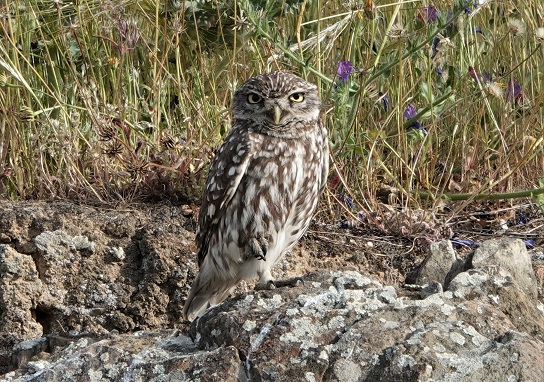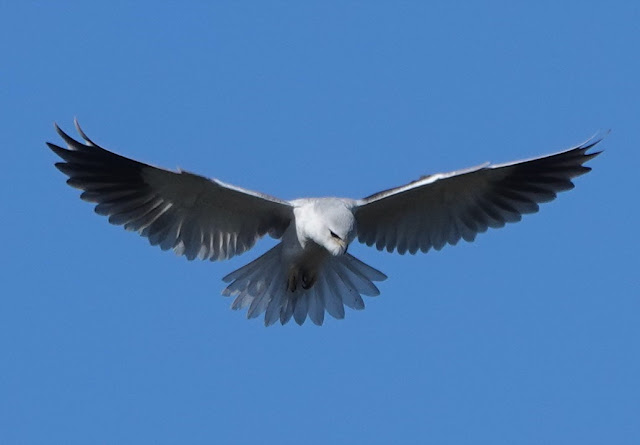The Sociable Enigma
 |
| Sociable Lapwing on plains in Extremadura (Martin Kelsey) |
Nearly 6000 km from where it had hatched, this bird was spending its first winter on what is commonly called the steppes of Extremadura. Now if anything knows what real steppes are like, it would be this species, the Sociable Lapwing. Formerly breeding across much of the Central Asian steppes, it is now considered as Critically Endangered, with a global population (according to Wiersma et al 2020) of perhaps 16,000 individuals. It has declined greatly, its breeding range now pretty much restricted to an area in northern Kazakhstan. Unlike the natural steppe habitat on its breeding range (although that is becoming degraded by agriculture), the open plains of Extremadura are ecologically better described as pseudosteppe. Originally oak forest, these vast tracts of land were cleared by people over many centuries for farming. The open landscape thus created has brought with it steppic species, like Calandra Larks, bustards, sandgrouse and harriers. This soft grey-brown plumaged plover, with whitish underparts, some gentle streaking on the breast, rather long black legs and Dotterel-like broad pale supercilium circumnavigating its dark-capped-head, would have felt at home here.
Looking at eBird winter records (December-February) in the last ten years, something striking emerges. There are wintering records in Gujarat, Rajasthan and central Pakistan, Iran, the Gulf states, the Red Sea coast and Israel. Sudan used to be a known-wintering area, but eBird shows no recent records there (although coverage will be minimal). The only other region with clusters of sightings is the Iberian Peninsula. Interestingly, as the number of records of vagrant Sociable Lapwings in Western Europe has declined (there has not been any recorded in the UK since 2008), the numbers seen in Iberia have been sustained. Since the winter of 2011/2012, there have been at least two overwintering Sociable Lapwings in the region each year, and most recently, at least four or five individuals. I estimate that there have been about wintering 25 Sociable Lapwings seen since 2010 (although some may have been birds recorded in more than one winter, i.e. returning birds).
 | |
|
What is even more revealing is that of these 25 individuals, ten were seen in Extremadura. Indeed in the winter of 2018/2019, there were at least three in Extremadura, and the same happened last winter (2019/2020). This makes Extremadura the best place in Europe to look for Sociable Lapwing in winter and possibly the region may hold a tiny, regular wintering population.
Presumably Sociable Lapwings arrive and depart with flocks of its common wintering congener, the Northern Lapwing. The latter species also is a summer visitor to the steppes of Central Asia and whilst some will migrate south to India, perhaps others head westwards into Europe. Northern Lapwings are called "Cold Birds" or "Snow Birds" in Spanish because of their association with winter. However, once established on its winter patch, the Sociable Lapwings I have seen in Extremadura become decidedly anti-sociable. They tend to be amazingly faithful to a particular area, even to just the corner of a single field, and whilst Northern Lapwings come and go, the Sociable Lapwing appears indifferent. This changes by late February when the Northern Lapwings are forming pre-migratory flocks and sightings of their much rarer eastern cousin tend to be in concert with them.
 |
| Sociable Lapwing on passage late February in Extremadura, with Northern Lapwing (Martin Kelsey) |
The most recent Sociable Lapwing I have seen in Extremadura was a first-winter bird found by a friend of mine, Neil Renwick, whilst out walking his dog. For several weeks it stayed close to patches of fodder put out for the local breed of beef cattle, the Retinto. Sometimes out of view in the folds of the terrain, it would sooner or later return to forage there. In typical plover fashon, its long legs make a few paces before a pause, followed by a few more paces, often tangentially. The straw on the ground was clearly a haven for invertebrates on which it fed. It was invariably alone and during many hours of watching it, I never ever saw it fly. I saw it there for the last time on 5th February.
 |
| First winter Sociable Lapwing showing pale and dark tipped covert feathers (Martin Kelsey) |
Nearly three weeks later, I was birding with a group of international guests who had been invited to attend the Extremadura Bird Fair. The famous bird artist, Lars Jonsson, was in the group and I knew that he was especially keen to see Sociable Lapwing - it would have been a lifer for him. But I and several other people had checked the site since 5th February for the bird, but to no avail. We were convinced that it had gone.
 |
| A day in Extremadura - from left: Martin Kelsey, Tim Appleton, David Lindo, Lars Jonsson |
Wiersma, P., G. M. Kirwan, and C.J. Sharpe (2020). Sociable Lapwing (Vanellus gregarius), version 1.0. In Birds of the World (J. del Hoyo, A. Elliott, J. Sargatal, D. A. Christie, and E. de Juana, Editors). Cornell Lab of Ornithology, Ithaca, NY, USA. https://doi.org/10.2173/bow.soclap1.01



Comments
I am glad you liked it. I remember you and Les telling me about your sighting! Take care and best wishes, Martin